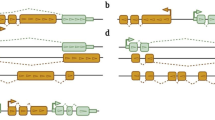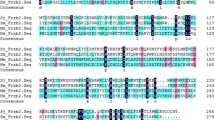Abstract
Clonorchis sinensis (C. sinensis) infection is still a common public health problem in freshwater fish consumption areas in Asian countries. More molecular evidence are required to speed up the prevention strategies to control this kind of infectious disease. In the present study, to confirm the biological importance of Csenolase followed by our previous observations of the key metabolic enzyme, we explored the RNA silence effect of the Csenolase-derived RNA interference (RNAi) in C. sinensis. The extramembranous region aa105–226 was selected as the target sequence of RNA silence. Csenolase-derived double strand RNA (dsRNA-Csenolase, 366 bp) was synthetized and delivered into C. sinensis by soaking approach. The penetration of dsRNA into adult worms and metacercariae was tracked using fluorescently labeled RNA. Western blotting and qRT-PCR experiments were performed to determine dsRNA-Csenolase-silencing effect. Our results showed that, after incubating for 120 h, dsRNA-Csenolase could effectively target and downregulate the expression of Csenolase in both adult worms (P < 0.001) and metacercariae (P < 0.01), resulting in a remarkable killing effect on C. sinensis adult worms (P < 0.01). Fluorescent Cy3-labeled dsRNA was mostly deposited in the uterus and vitellarium of adult worm and in the cyst wall of metacercaria. The present study is the first report of RNAi trials in C. sinensis, allowing further applications in identifying functional genes in C. sinensis.






Similar content being viewed by others
References
Bernal D, de la Rubia JE, Carrasco-Abad AM, Toledo R, Mas-Coma S, Marcilla A (2004) Identification of enolase as a plasminogen-binding protein in excretory-secretory products of Fasciola hepatica. FEBS Lett 563:203–206
Chen N, Xu MJ, Nisbet AJ, Huang CQ, Lin RQ, Yuan ZG, Song HQ, Zhu XQ (2011) Ascaris suum: RNAi mediated silencing of enolase gene expression in infective larvae. Exp Parasitol 127:142–146
Chen N, Yuan ZG, Xu MJ, Zhou DH, Zhang XX, Zhang YZ, Wang XW, Yan C, Lin RQ, Zhu XQ (2012) Ascaris suum enolase is a potential vaccine candidate against ascariasis. Vaccine 30:3478–3482
Correnti JM, Pearce EJ (2004) Transgene expression in Schistosoma mansoni: introduction of RNA into schistosomula by electroporation. Mol Biochem Parasitol 137:75–79
Feo S, Arcuri D, Piddini E, Passantino R, Giallongo A (2000) ENO1 gene product binds to the c-myc promoter and acts as a transcriptional repressor: relationship with Myc promoter-binding protein 1 (MBP-1). FEBS Lett 473:47–52
Fire A, Xu S, Montgomery MK, Kostas SA, Driver SE, Mello CC (1998) Potent and specific genetic interference by double-stranded RNA in Caenorhabditis elegans. Nature 391:806–811
Gan W, Zhao G, Xu H, Wu W, Du W, Huang J, Yu X, Hu X (2010) Reverse vaccinology approach identify an Echinococcus granulosus tegumental membrane protein enolase as vaccine candidate. Parasitol Res 106(4):873–882
Hong ST, Fang Y (2012) Clonorchis sinensis and clonorchiasis, an update. Parasitol Int 61:17–24
Issa Z, Grant WN, Stasiuk S, Shoemaker CB (2005) Development of methods for RNA interference in the sheep gastrointestinal parasite, Trichostrongylus colubriformis. Int J Parasitol 35:935–940
Kumar S, Tamura K, Nei M (1994) MEGA: Molecular Evolutionary Genetics Analysis software for microcomputers. Comput Appl Biosci 10(2):189–191
Kume A, Boldbaatar D, Takazawa Y, Umemiya-Shirafuji R, Tanaka T, Fujisaki K (2012) RNAi of the translation inhibition gene 4E-BP identified from the hard tick, Haemaphysalis longicornis, affects lipid storage during the off-host starvation period of ticks. Parasitol Res 111(2):889–896
Li WQ, Hu XC, Zhang X, Ge Y, Zhao S, Hu Y, Ashman RB (2011) Immunisation with the glycolytic enzyme enolase confers effective protection against Candida albicans infection in mice. Vaccine 29:5526–5533
Lun ZR, Gasser RB, Lai DH, Li AX, Zhu XQ, Yu XB, Fang YY (2005) Clonorchiasis: a key foodborne zoonosis in China. Lancet Infect Dis 5:31–41
Manzano-Roman R, Oleaga A, Perez-Sanchez R, Siles-Lucas M (2012) Gene silencing in parasites: current status and future prospects. Adv Parasitol 78:1–55
Pfarr K, Heider U, Hoerauf A (2006) RNAi mediated silencing of actin expression in adult Litomosoides sigmodontis is specific, persistent and results in a phenotype. Int J Parasitol 36:661–669
Piratae S, Tesana S, Jones MK, Brindley PJ, Loukas A, Lovas E, Eursitthichai V, Sripa B, Thanasuwan S, Laha T (2012) Molecular characterization of a tetraspanin from the human liver fluke, Opisthorchis viverrini. PLoS Negl Trop Dis 6:e1939
Skelly PJ, Da’dara A, Harn DA (2003) Suppression of cathepsin B expression in Schistosoma mansoni by RNA interference. Int J Parasitol 33:363–369
Sripa J, Pinlaor P, Brindley PJ, Sripa B, Kaewkes S, Robinson MW, Young ND, Gasser RB, Loukas A, Laha T (2011) RNA interference targeting cathepsin B of the carcinogenic liver fluke, Opisthorchis viverrini. Parasitol Int 60:283–288
Stefanić S, Dvořák J, Horn M, Braschi S, Sojka D, Ruelas DS, Suzuki B, Lim KC, Hopkins SD, McKerrow JH, Caffrey CR (2010) RNA interference in Schistosoma mansoni schistosomula: selectivity, sensitivity and operation for larger-scale screening. PLoS Negl Trop Dis 4:e850
Tarry M, Jääskeläinen M, Paino A, Tuominen H, Ihalin R, Högbom M (2011) The extra-membranous domains of the competence protein HofQ show DNA binding, flexibility and a shared fold with type I KH domains. J Mol Biol 409:642–653
Thompson JD, Higgins DG, Gibson TJ (1994) CLUSTAL W: improving the sensitivity of progressive multiple sequence alignment through sequence weighting, position-specific gap penalties and weight matrix choice. Nucleic Acids Res 22(22):4673–4680
Vanegas G, Quiñones W, Carrasco-López C, Concepción JL, Albericio F, Avilán L (2007) Enolase as a plasminogen binding protein in Leishmania mexicana. Parasitol Res 101(6):1511–1516
Wang X, Chen W, Huang Y, Sun J, Men J, Liu H, Luo F, Guo L, Lv X, Deng C, Zhou C, Fan Y, Li X, Huang L, Hu Y, Liang C, Hu X, Xu J, Yu X (2011a) The draft genome of the carcinogenic human liver fluke Clonorchis sinensis. Genome Biol 12:R107
Wang X, Chen W, Hu F, Deng C, Zhou C, Lv X, Fan Y, Men J, Huang Y, Sun J, Hu D, Chen J, Yang Y, Liang C, Zheng H, Hu X, Xu J, Wu Z, Yu X (2011b) Clonorchis sinensis enolase: identification and biochemical characterization of a glycolytic enzyme from excretory/secretory products. Mol Biochem Parasitol 177:135–142
Wang X, Chen W, Lv X, Tian Y, Men J, Zhang X, Lei H, Zhou C, Lu F, Liang C, Hu X, Xu J, Wu Z, Li X, Yu X (2012) Identification and characterization of paramyosin from cyst wall of metacercariae implicated protective efficacy against Clonorchis sinensis infection. PLoS One 7:e33703
Wang X, Liang C, Chen W, Fan Y, Hu X, Xu J, Yu X (2009) Experimental model in rats for study on transmission dynamics and evaluation of Clonorchis sinensis infection immunologically, morphologically, and pathologically. Parasitol Res 106(1):15–21
Wu X, Zhan X, Gan M, Zhang D, Zhang M, Zheng X, Wu Y, Li Z, He A (2013) Laccase2 is required for sclerotization and pigmentation of Aedes albopictus eggshell. Parasitol Res 112(5):1929–1934
Yang J, Qiu C, Xia Y, Yao L, Fu Z, Yuan C, Feng X, Lin J (2010) Molecular cloning and functional characterization of Schistosoma japonicum enolase which is highly expressed at the schistosomulum stage. Parasitol Res 107(3):667–677
Yang Y, Jin Y, Liu P, Shi Y, Cao Y, Liu J, Shi Y, Li H, Lin J (2012) RNAi silencing of type V collagen in Schistosoma japonicum affects parasite morphology, spawning, and hatching. Parasitol Res 111:1251–1257
Zhou Z, Xia H, Hu X, Huang Y, Ma C, Chen X, Hu F, Xu J, Lu F, Wu Z, Yu X (2008) Immunogenicity of recombinant Bacillus subtilis spores expressing Clonorchis sinensis tegumental protein. Parasitol Res 102:293–297
Zou X, Jin YM, Liu PP, Wu QJ, Liu JM, Lin JJ (2011) RNAi silencing of calcium-regulated heat-stable protein of 24 kDa in Schistosoma japonicum affects parasite growth. Parasitol Res 108(3):567–572
Acknowledgments
This work was supported by the National Key Basic Research and Development Project (973 project; no. 2010CB530000) and National Natural Science Foundation of China (no. 81171602) to XBY. The work was supported in part by the National Natural Science Foundation of China (no. 81101270) to YH.
Author information
Authors and Affiliations
Corresponding author
Rights and permissions
About this article
Cite this article
Wang, X., Chen, W., Tian, Y. et al. RNAi-mediated silencing of enolase confirms its biological importance in Clonorchis sinensis . Parasitol Res 113, 1451–1458 (2014). https://doi.org/10.1007/s00436-014-3785-0
Received:
Accepted:
Published:
Issue Date:
DOI: https://doi.org/10.1007/s00436-014-3785-0




